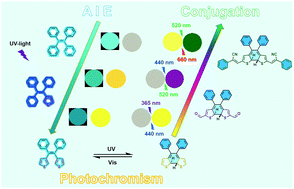Multiwavelength-controlled multicolor photochromism and fluorescence switching based on an efficient photocyclization reaction by introducing two photoactive subunits into AIEgens†
Abstract
Photochromic materials have recently attracted much attention in optoelectronic devices and optical storage systems because of their excellent reversible photoresponse performance. However, most traditional photochromic molecular systems have the limitation of aggregation caused quenching (ACQ) in the aggregation state, which greatly limits their practicability. Herein, two photoactive units with varied conjugated structures are introduced into an AIE-active tetraarylethene skeleton, which allows us to achieve multicolor photochromic systems with a color and fluorescence dual-signaling mode and selective response to different wavelengths of light. It is found that the photo-triggered photochromism is attributed to the reversible cyclization/cycloreversion reaction, and the fatigue of photochromism in solution is due to the occurrence of cyclization–dehydrogenation reaction under UV irradiation but it can be avoided when visible light is used. Introducing two photoactive units can also significantly improve the thermal stability of cyclized products and fatigue resistance to UV irradiation, and it can greatly promote the cyclization efficiency in solution enhancing photochromic performance. The increasing conjugation degree of the photoactive unit enables these compounds to realize multiwavelength-controlled coloration and decoloration processes using UV/visible light with different wavelengths, and this feature of multicolor photochromism and fluorescence switching has great potential applications in the field of information storage and multiple anti-counterfeiting.



 Please wait while we load your content...
Please wait while we load your content...